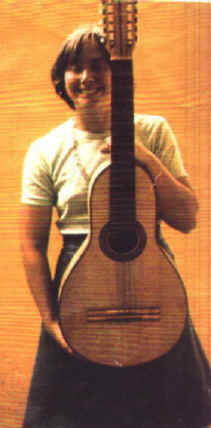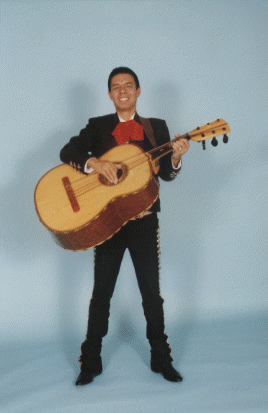Latin American
LARGE guitars!
Travelling through the Spanish countryside in the early 1600s, Cervantes (the "Spanish Shakespeare') described a large guitar, the "Bajo de uña" or "Fingernail Bass." It is likely that this instrument found its way to the new Spanish colonies in the Americas and survives today in several countries: at least two variants in Mexico, at least one in Argentina and one in Puerto Rico.
Puerto Rico
In Puerto Rico a large six-string instrument was described by Manuel Alonso in the
mid-1800s. The instrument formed part of the traditional string ensemble of the time
called "orquesta jíbara," which played in salon society. The instrument became
popular at the turn of the century as a deep-voiced melody instrument when it changed form
and stringing to 4 and then 5 octaved double courses. By the twenties and thirties it had
grown to be almost seven inches deep, and was known for it unique "quivering"
tone, and it was sometimes known as the "weeping bordonua." It was large and
odd-looking and was replaced in the "orquesta jibara" by the guitar.
For all musical purposes the instrument became obsolete until the fifties when the great
Puerto Rican musician and folklorist Paquito Lopez Cruz began to teach its technique once
again, after the government began a series of yearly contests in order to urge makers to
build bordonuas...and as well, several other disappeared instruments, besides. The
instrument is almost ubiquitous once again today, and is often seen in the back row of the
many community string orchestras which can be seen around the island today.
Argentina
Yes, there exists an oddly-configured Guitarron Argentino. I am currently seeking more
information about this unusual instrument which features a series of resonating strings
which are stretched across its face, besides the usual plucked strings across its neck. I
was able to obtain this beautiful photograph from FUNDEF, a South American Instrument
research organization, and this sound clip.
Mexico
The six string Mexican guitarron, also called the Guitarron de Toloche is characteristic
of the state of Jalisco, and is the one most often seen in the Mariachi ensemble. It is
often tuned A-D-G-C-E-A, but sometimes is tuned like a guitar but an octave lower. In
Mariachi music, the guitarrón replaced the harp, which required an additional ensemble
member simply to carry it through the streets while the harpist played.
There is a also four-string model in Mexico which originated in the isthmus of Tehuantepec. Some of the prominent mexican guitarron makers are Humberto Zavala Ildefonso, Humberto Morales of Guadalajara and Luis Espinosa of Michoacan.
More on the Guitarron from the San Antonio Cultural Society.



